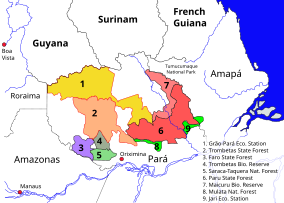Maicuru Biological Reserve
| Maicuru Biological Reserve | |
|---|---|
| Reserva Biológica Maicuru | |
|
IUCN category Ia (strict nature reserve)
|
|

Protected areas of north west Pará.
7. Maicuru Biological Reserve |
|
| Nearest city | Oriximiná, Pará |
| Coordinates | 1°16′41″N 54°04′40″W / 1.278°N 54.0778°WCoordinates: 1°16′41″N 54°04′40″W / 1.278°N 54.0778°W |
| Area | 1,151,761 hectares (2,846,060 acres) |
| Designation | Biological reserve |
| Created | 4 December 2006 |
| Administrator | Secretaria de Estado de Meio Ambiente, Belém |
The Maicuru Biological Reserve (Portuguese: Reserva Biológica Maicuru), is a strictly protected biological reserve in the state of Pará, Brazil. It covers 11,518 square kilometres (4,447 sq mi) of Amazon rainforest.
The reserve lies between the Maicuru and Jari rivers on the border between the states of Pará and Amapá. It includes parts of the basins of the Maicuru, Paru and Jari rivers. It covers 1,151,761 hectares (2,846,060 acres) of Amazon biome. The park is mostly within the municipality of Almeirim (94.49%) with a small part in the municipality of Monte Alegre (5.51%). It is part of the mosaic of protected areas known as the Calha Norte do rio Amazonas. It adjoins the Tumucumaque Indigenous Park, Rio Paru d'Este Indigenous Territory, Tumucumaque Mountains National Park and Paru State Forest.
Almost all the reserve is in the Paru-Jari basin formed by the Itapecuru, Ipitinga, Careparu, Paru and Jarí rivers. The south of the reserve is in the Cuminapanema-Maicuru basin, formed by the Maicurú, Curuá, Mamiá, Cuminapanema and Jauaru rivers. The total length of water courses in the reserve is about 3,700 kilometres (2,300 mi). The reserve is accessible only by small aeroplane through landing strips in four mining areas in the south-central portion and one in the north-central portion.
The reserve was created by state decree 2610 of 4 December 2006 with the objectives of preserving the natural environment and ecosystem, supporting scientific research and supporting environmental education. The conservation unit is fully protected. As a biological reserve the purpose is to provide full protection without human interference and allow only indirect use of the natural resources. Public access is prohibited except for educational purposes as defined by the management plan, and scientific research requires prior approval by the Pará Secretary of State for the Environment (SEMA/PA). The reserve is in the Center of Guiana Endemism, which spans parts of Brazil, Venezuela, Guyana, French Guiana and Suriname. It may be considered a "mega reserve", aiming to protect a complete sample of species with the space needed to perpetuate themselves over the generations.
...
Wikipedia

